Greek philosopher Thales of Miletus was probably the earliest known researcher into the effects of static electricity around 600BCE, but electricity would remain little more than an intellectual curiosity for millennia until 1600, when the English scientist William Gilbert wrote De Magnete, in which he made a careful study of electricity and magnetism, distinguishing the lodestone effect from static electricity, which could be produced by rubbing amber. Gilbert coined the new Latin word electricus (from the Greek word electron, (being ‘of amber’) to refer to the property of attracting small objects after being rubbed. This association gave rise to the English words ‘electric’ and ‘electricity’, which made their first appearance in print in Thomas Browne’s Pseudodoxia Epidemica of 1646.
Further studies were conducted in the 17th and early 18th centuries by Otto von Guericke, Rodert Boyle, Stephen Gray, and C F du Fay, but it wasn’t until later in the 18th century that Benjamin Franklin was credited as having conducted extensive researches into electricity, selling his possessions to fund his studies. In June 1752 Franklin is reputed to have attached a metal key to the bottom of a dampened kite string and flown the kite in a storm-threatened sky, resulting in a succession of sparks jumping from the key to the back of his hand, and so demonstrating that lightning was of an electrical nature. He also explained the apparently paradoxical behaviour of the Leyden jar as a means for storing large amounts of electrical charge, in terms of electricity consisting of both positive and negative charges.
Therefore, the principles of electricity have been around for a lot longer than the internal combustion engine, but adapting the phenomenon to propel even a simple cycle in any really practical sense, proved to have its difficulties. It was the 1890s before the first electric bicycles were documented within various US patents.
On 31 December 1895, Ogden Bolton Jr. registered US Patent 552271 for a battery-powered bicycle with ‘6-pole brush-and-commutator direct current (DC) hub motor mounted in the rear wheel’. There were no gears and the motor could draw up to 100 Amps from a 10-Volt battery.
Two years later, in 1897, Hosea W Libbey of Boston invented an electric bicycle that was propelled by a ‘double electric motor’, which was registered under US Patent 596272. The motor was designed within the hub of the crank axle (a system which was later re-invented and imitated in the late 1990s by Giant Lafree e-bikes).
By 1898 a rear-wheel drive electric bicycle, which used a belt drive along the outside edge of the wheel, was patented by Mathew J Steffens and, in 1899, US Patent 627066 by John Schnepf depicted a rear-wheel friction ‘roller-wheel’ style drive electric bicycle. Schnepf’s invention was later re-examined and expanded in 1969 by G A Wood Jr with his US Patent 3431994, where his device used four fractional horsepower motors connected through a series of gears.
Changes in the British government’s approach to electric vehicles began to encourage the prospects for their development when, in March 1980, it abolished vehicle excise duty (road tax) for electric vehicles and, by the start of 1983, the Department of Transport was working on legislation to introduce a new category of vehicle: an ‘electrically assisted pedal cycle’.
Prompted by a manufacturers’ lobbying campaign from the likes of Raleigh, who wanted to sell electric bicycles, the legislation was passed in August 1983. The specifications however, imposed a number of restrictions that limited the performance of any vehicle that would qualify under the new standards.
The maximum legal speed of the vehicle would be limited to only 15 miles per hour (24km/h); it could not weigh any more than 60 kilogrammes (130lb), including the battery; and its motor could not be rated at any more than 250 Watts.
So what curiosities might we find in early modern era examples of these dreams to electrify a bicycle?
![]()
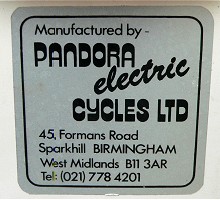
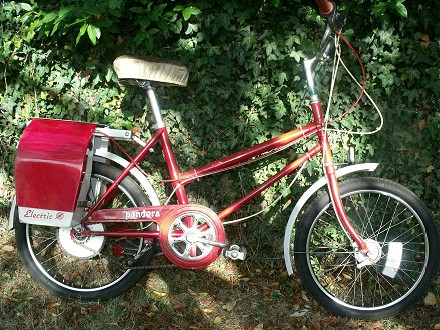
Our Pandora P3 is quite a mystery machine, since there seems to be no information available anywhere on this machine or its manufacturer to help us with our research, so all we have is what we can glean from the bike.
Labels on the back of the panniers tell us it came from Pandora Electric Cycles Ltd, 45 Formans Road, Sparkhill, Birmingham, Warwickshire, and that it is powered from two 12V × 14amp-hour batteries. Opening the right-hand pannier, we can see the electric motor is a Bosch 12V × 200W rating, so the batteries must be connected in parallel, which should give the bike some reasonable assistance when it’s fired up.
With one lead–acid motor cycle battery beneath the motor, which is mounted at the top of the pannier, and a stop–go solenoid operated by cable to the twistgrip throttle, there’s clearly no speed controller in this circuit—it’s simple all-or-nothing power.
We figure the second battery was in the left-hand pannier for balance, where we also find a built-in charger, and a label that tells us the fibreglass panniers were made by Proctors Plastics, 93 Berkley Road East, Heymills, Birmingham, B25 8PW. On the top-rear of the left-hand pannier there’s a connector for a charging lead, which screws on and plugs into mains voltage, while small orange and red lights are fitted through the pannier at the front-top, and would presumably indicate some state of charge.
The motor spindle goes through the inside wall of the pannier, to drive a pinion for a toothed belt, to a larger intermediate pulley with a smaller freewheel reduction sprocket driving a further larger sprocket fitted to drive the three-speed Sturmey–Archer AB rear brake hub.
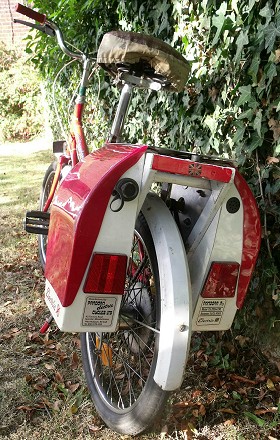
This means that when the pedals are turned to cycle the bike, that the larger motor sprocket and its driving chain will freewheel at the reduction sprocket, so the motor won’t turn, but you would still expect to experience some drag from the additional chain and sprocket set.
When the electric motor is fired up to drive the bike, it will however back-drive the pedal set, and the pedals will be rotated by the motor, so Pandora’s rider would normally need to continue the cycling motion under power, though that may presumably involve less effort. The cycle pedal chain is sprung by a tensioner on the bottom run.
The rear brake cable is connected to operate from the right-hand handlebar lever, while the front hub brake is worked by the left-hand lever, though we can make out no obvious reason why the brakes should be connected in reverse orientation?
The WICO pedals are made in West Germany, the Sturmey–Archer rear hub is coded 6–84 (June 1984), and the Rigida (France) Super Chrolux rims dated 7–84, which probably suggests that Pandora would date around 1984–85.
Pandora has a metric 40cm step-through ‘shopper’ frame, with 20×1¾ Semperit (Austrian) tyres, but we don’t know the actual make of the unbranded cycle, since it is only identified by Pandora decals.
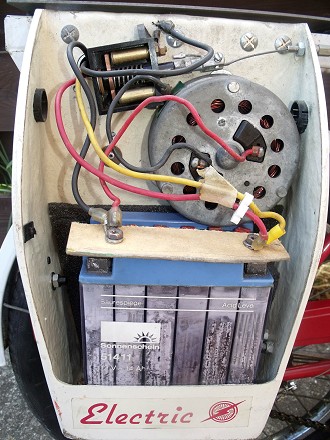
It is notable that this bike is indicated as Pandora P3, which might be taken as a model designation, so maybe there were also P1 and P2 models … or possibly there weren’t, and the P3 may simply refer to the bike having a three-speed hub. Who knows?
The frame is equipped with an ESGE L12 Pletscher (Swiss) cast-alloy cycle centre stand, which looks like an odd side stand with two legs when up on the left-hand side, but fold down and the top leg kicks out to the right as it folds down, to become a centre stand! The pity is that it doesn’t really work so well because of Pandora’s weight at the back. The steering tends to swing round, and the bike falls over. It might be a good stand for a normal bicycle, but it really doesn’t work so well for Pandora with her apparent weight problem.
Putting Pandora on the scales, we find she weighs nearly 4 stone (56lb) at the back, but only 10lb at the front–that’s some imbalance, which is obviously going to cause problems from time-to-time, and particularly when wrestling to manhandle the bike onto its stand.
The Sturmey three-speed epicyclic hub is switched by a three-speed Sturmey trigger change on the handlebar, and Sturmey plastic brake levers are in charge of the stopping department.
Right, we think we’ve figured out everything we can, so time to give it a try…
We cycle around the road first to get the feel of the ride, trigger through the gears, and test the brakes, which all seem to be working OK. Pedalling as a normal bicycle, you do notice some minor drag from the extra chain run, while the freewheel works normally ‘off power’, but trying to back pedal feels really heavy, because that will be turning the motor over backward through the freewheel.
This time we’re riding as pacer on The Dalek with the sat-nav, because Pandora is being piloted by a fit and accomplished amateur cyclist, who’s expected to give a better performance than we probably would.
Since the e-motor drives through the hub in the same way as the cycling action, the electric motor also functions in three-speed ratios, which really helps against hills without sapping the batteries so much in the middle and lower ratios. Change into third along the straight, twist open the throttle to engage the solenoid and those two 12V × 14Ah batteries will kick in 200W of power from the motor, which helps Wendy to pedal-assist Pandora up to a top paced speed of 25mph.
Since Pandora’s pedals continue to rotate under power from its electric motor, it’s probably not a good idea to take your feet off the pedals and rest them on the frame crossbar, since the flailing pedals could easily deliver a nasty clout if your feet stray off the centreline. It’s absolutely best practice with Pandora, to keep your feet on the pedals at all times when the e-drive is engaged, so it’s extremely difficult to ascertain what speed the bike might achieve on e-power alone.
To safely test the speed capability of the e-motor drive alone would probably require the cycle pedal chain to be completely removed and, presuming good batteries, we can only expect that the e-motor might pull the bike along up to around 15mph along the flat in third gear, to be compliant with the legislation.
Pandora’s speed capability and range can only be considered according to how good the battery condition may be, and how much effort the rider may input to assist the bike.
Unlike modern EAPC specification electric bikes, where speed sensors automatically cut the motor power at their maximum speed, Pandora’s primitive technology has no speed limiter and doesn’t cut out its e-drive at 15.5mph, so it’s much easier to pedal the bike faster than today’s 25km/h limit. A modern e-bike can be pedalled up to higher top speeds than 15.5mph, but that would all be rider effort, since the e-motor would have stopped contributing at the bike’s maximum design speed.
You probably wouldn’t ordinarily be able to get a 20-inch shopper bike up to 25mph, and certainly couldn’t maintain that speed like Pandora could, but it’s probably not so practical to go shopping on since the panniers are already crammed full of the bike’s heavy electrical equipment, which may seem to defeat its purpose.
The hub brakes worked quite effectively up to the performance of the bike, but we never did figure out whether it was intended to have a ‘reversed brake’ configuration, or if someone had just cabled it up wrongly?

Pandora however, would soon find itself facing some daunting competition…
![]()
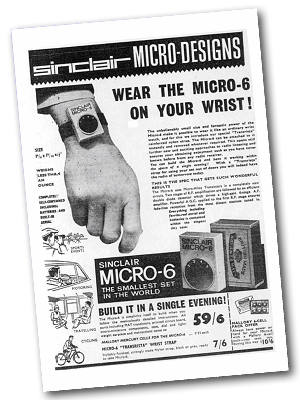
1964: the Sinclair Micro-6 ‘matchbox’ radio
Clive Marles Sinclair, born 30th July 1940, had spent several years as assistant editor of Instrument Practice, before founding Sinclair Radionics in 1961, where he produced the first slim-line electronic pocket calculator (the Sinclair Executive) in 1972. Sinclair later moved into the production of home computers, presenting the ZX80 as the UK’s first mass-market home computer for less than £100, then later with Sinclair Research, the ZX81 and ZX Spectrum, which was widely acknowledged as an important development in the early days of the British home computer industry.
Sinclair Research also produced the TV80 flat screen portable television using an ingenious cathode ray tube design, however LCD television technology was also developing at this time, and the Sinclair FTV1 (TV80) proved a commercial loss with only 15,000 units produced.
Thanks to his electronic inventions, Sinclair had become one of the UK’s best-known technology millionaires, which earned him a knighthood in 1983.
Now Sir Clive Sinclair, he had held a long-running interest in electric vehicles and perceived that an electrically assisted pedal cycle might offer a number of significant transportation advantages, since such a vehicle would be exempt from insurance and vehicle tax, and the user would not need a driving licence, nor have to wear a motor cycle crash helmet, all of which were required for mopeds.
Sinclair had already begun an assessment project towards development of a C1 electric vehicle back in 1979, as a one-person, battery-electric, alternative cycle-based vehicle to replace the moped. To meet the steadily escalating development costs of the vehicle, Sinclair decided to raise capital by selling some 10% of his own shares in Sinclair Research to fund a separate company that would focus on electric vehicles. A £12 million deal was reached in March 1983, of which £8.3 million was used to fund the establishment of the new Sinclair Vehicles Company.
Evolved as a progression from the initial C1 project, in the autumn of 1983 Sinclair brought in Lotus Cars to finish the vehicle’s detailing, build prototypes and test rigs, carry out testing and take forward the programme to production.
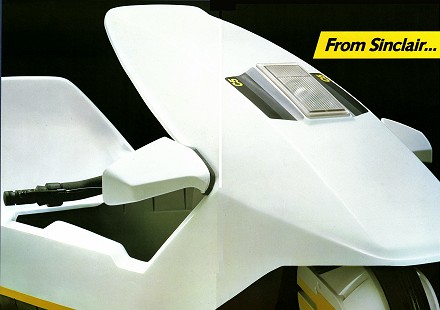
In 1984, as Sinclair launched a new Sinclair QL computer intended for professional users, Sinclair Vehicles established a new head office at Coventry in the West Midlands, as an area with a long-established link to the motor industry.
Development of the new electric vehicle took place over 19 months under conditions of great secrecy, with testing carried out at the Motor Industry Research Association’s proving ground in nearby Leicestershire, while development of the ZX Spectrum home computer series continued toward release of the enhanced ZX Spectrum 128 for 1985.
The Sinclair C5 was unveiled at a glitzy launch event on 10 January 1985, as a battery powered tricycle with its polypropylene body designed by Lotus. It was priced at a basic £399, or £428 by mail order delivery, with Sir Clive predicting anticipated sales of 100,000 in the first year.
With a wide range of accessories further offered such as wing mirrors, indicator kits, electric horn, mud flaps, safety High-Vis mast, a range of weather protection fittings, seat liner and cushion, and spare battery, then the total bill for a fully appointed machine could potentially creep up to more than £600.

January 1985: Eastern Electricity Board
staff newspaper
The C5 launch was backed by a further £3 million advertising campaign, while some 2,500 C5s had reportedly already come off the production line at Hoover’s Merthyr Tydfil factory in South Wales, which had been contracted to build the vehicle.
Officially given the green light for road use by the Department of Transport, it could be driven on public roads without a licence, insurance or tax by anyone over 14. Although the user need receive no training, nor wear a crash helmet or safety belt, the Department of Transport stated that, ‘The specifications of the machine meet and, in some cases, exceed the demands of legislation. When considered as an alternative to pedal cycles, it was not thought likely to demonstrate any worse safety record, though if large numbers came to be used on the roads, then statistically it would be accepted that they would be involved in occasional accidents and their record will be closely monitored’.
Following the launch, machines appeared on display at Electricity Board showrooms, though initial availability was by direct mail order, with the machine arriving in a cardboard box. It didn’t generally start becoming available in shops, supermarkets department stores and Woolworths until several months afterwards.
Our C5 is presented as the standard basic model with no extras.
Its electrical operation is monitored and controlled by a microchip produced by Ferranti. The basic weight of 66lb is achieved by using polypropylene plastic for the body shell, which is mounted on a spinal steel chassis. The wheels are moulded from glass-reinforced nylon and covered with polypropylene trims. The components had been developed by more than 30 companies, mostly British, but the motor (derived from washing machine technology) comes from Italy. The battery is connected to a domestic power socket for overnight recharging, with servicing and spares supplied through Hoover outlets.
The vehicle is less than six feet long and only 2ft 7in high. In the manner of a low recumbent bicycle, the driver sits with legs extended to the pedals in the front of the cockpit, which are a legal necessity, and essential when the battery gives out, which could be anything from 11 to 25 miles according to how much pedal assistance the rider might contribute. It has a small boot rated 1cuft (28 litres), with a 10kg weight capacity. The front and rear lights are operated from a rocker switch at the left front edge of the seat.

When you get in, the handlebars are situated beneath your legs just forward of the seat, and there are front (right) and back (left) brake levers in conventional cycle fashion; the back brake lever has a latch to act as a parking brake if required.
It’s best practice to first pedal up and down the road a couple of times to get the feel of the controls and steering, and the first thing you discover is that C5 requires a huge 20ft turning circle! This is of little matter when actually driving, but will create some issues when trying to navigate the vehicle in a confined space, where it’s usually easier to dismount and lift the light body shell from the front to turn on the spot.
The other thing you become very aware of, is how low to the ground you are, which would immediately raise ‘concerns’ about use among road traffic, its visibility, and your personal safety.
Confidence with the controls is mastered surprising quickly, so we’re soon ready to try it under power.
Engage the isolator and the instrument display lights up in the top of the pod. This isn’t anything like a car dashboard. There’s no speedometer … well nothing in the normal sense of what you might expect, just two bands of lights!
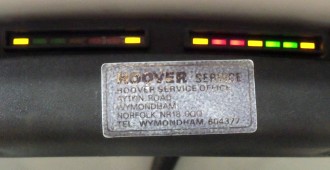
The right hand band is a battery condition indicator, with yellow lights at each end to show the system is on, two green lights to the right indicating stages of good charge, another yellow in the middle to indicate half charge, then two reds to the left warning of stages of discharge. The status lights start with all on, and then progressively go out as the battery discharges.
The left-hand band indicates load against the electric motor in a similar way, with one green indicating low power consumption, two greens a little higher, etc, to the reds showing higher power usage.
It’s recommended to pedal off every time, since this initial phase induces the greatest load against the motor, then once in motion, click on the left-hand handlebar button to kick in the electric motor drive. The power comes in simply by an on–off solenoid, so there is no speed control like a motor cycle throttle—just power or no power.
Because of the relatively low geared single-speed pedal ratio, it can be quite difficult and tiring to actually pedal the C5 up to maximum speed, so when you click in the power, the electric motor quickly, smoothly and quietly takes you beyond the pilot’s general pedalling range, up to a maximum of 24km/h (15mph), so it’s a vehicle that is normally intended to be run up to its top speed on the electric motor alone. The 15mph top speed tends to feel rather faster than it actually is because you’re so low to the ground, and you may not want to be taking some cambered corners at speed, because there could be stability issues, so 15mph is probably fast enough. When you release the power button C5 continues coasting along in a freewheel mode, which allows an ‘electrical economy cruising’ option of conserving battery power on downhill sections. The pedals would seem primarily to be there to get it moving from a standstill, for the rider to assist on inclines, and to be able to cycle it home if the battery goes flat.
Running along the flat or downhill on the e-motor, the load indicator lights stay on green, but against even light inclines, the machine readily slows down and the display quickly changes to red, and you appreciate that C5 is asking for assistance. A 12V × 36Ah battery powering a 250W electric motor does have capability limitations.
There are also occasional moments when you may be reminded that C5 has no reverse gear, so you have to get out to back up.
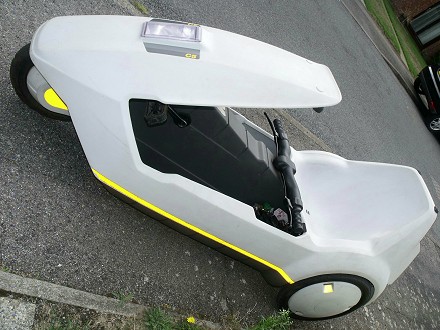
C5 will always attract lots of interest, and is a great novelty to drive, but many would probably have reservations about driving one through town traffic. It’d be difficult to imagine them being much use where hills might be involved, because the motor would have great difficulty in coping with such conditions, and pedalling one slowly up an incline could be both arduous and hazardous when other road traffic might be involved.
Sinclair was thoroughly convinced the C5 would be the social transport of the future and that everyone would want one, and he firmly staked his belief in its huge multi-million pound business investment, with a further personal risk of £7–£8 million. It was marketed as an alternative to cars, bicycles, and the moped, but received a less than enthusiastic reception from the British media. Its sales prospects were blighted by poor reviews and safety concerns expressed by consumer and motoring organisations. The vehicle’s limitations of a relatively short range with a battery that ran down quickly, lack of capability against inclines, a low maximum speed of only 15mph, and general lack of weatherproofing all contributed to make it impractical for most people’s needs. The optimistic forecasts of 8,000+ sales a month proved dramatically incorrect and, within just three months of the launch, production had already been slashed by 90%. After producing approximately 14,000 of the three-wheelers at the Hoover factory in South Wales, Sinclair Vehicles halted the production line in August 1985. Only 5,000 C5s were actually sold before Sinclair Vehicles called in the receiver on 15 October 1985. It was an utter commercial disaster of truly epic proportions. The C5 was intended to be the first in a series of increasingly ambitious electric vehicles but, following the crisis, planned development of the follow-up C10 and C15 electric cars never progressed beyond the drawing board.
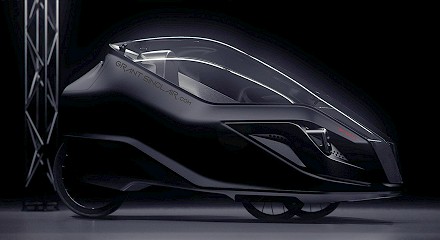
Grant Sinclair Iris Black
Photo: Grant
Sinclair.com
In April 1986, Sinclair Research sold the Sinclair trademark and its computer business to Alan Sugar at Amstrad for £5 million. Sinclair Research Ltd was reduced to an R&D business and holding company, with shareholdings in several spin-off companies that had been formed to exploit other technologies developed by the business. These included Anamartic Ltd (wafer-scale integration), Shaye Communications Ltd (CT2 mobile telephony), and Cambridge Computer Ltd (Z88 portable computers and satellite TV receivers). By 1990, Sinclair Reserch consisted of Sir Clive Sinclair and two other employees, from which its activities concentrated on personal transport, the Zike electric bicycle, Zeta bicycle motor, and the A-bike folding bicycle for commuters, which weighed just 5.5kg (12lb) and folded down small enough to be carried on public transport. By 1997, Sinclair Research had contracted further, to just Sinclair himself. In 2003, Sinclair Research was collaborating with Hong Kong-based firm Daka, with a laboratory set up near Croydon to develop products for Daka on a royalty basis. The two firms subsequently collaborated on a Sea Scooter and a wheelchair drive.
It’s now over 40 years since the C5 debacle bought about the virtual demise of Sir Clive Sinclair’s technology empire, and while maybe the famous e-trike didn’t turn out to be quite the capable alternative transportation vehicle that people were looking for, there are many who still say the idea was ahead of its time—and just that the time wasn’t right. Maybe using the e-technology of today, then the time might now be right to try an updated version of the C5 again—and that’s just what Clive Sinclair’s nephew is doing right now! Known as the Iris e-Trike, Grant Sinclair’s creation has a streamlined shape based on the aerodynamic helmets used in velodrome track cycle racing, and has a hinged aviation acrylic canopy to protect the rider from the elements. It’s constructed from a chromoly steel trike chassis inside a monocoque expanded foam polypropylene body. This new road-legal e-vehicle is equipped with four LED headlights, an LED rear lamp and brake light, and indicator signal lights. A removable 48V lithium-ion battery pack powering a 250W motor promises a range up to 50km on a one-hour charge, and drives the vehicle up to its restricted e-maximum of 15.5mph, above which the Iris is reportedly capable of being further pedalled by the rider up to speeds in excess of 30mph using the eight-speed cycle gearing. Total vehicle weight including battery and charger is 55kg, and Iris is further equipped with a 50-litre lockable boot. At 128cm (50 inches), the body height is also taller than that of the C5, providing better visibility for both rider and other road users. A combination of vents and charcoal filters deliver a fresh supply of air to the cabin, which also features a smart-phone docking station that can link to a rear camera, give GPS support, and music playback, while speed, distance, battery charge and power mode levels are displayed on a backlit LCD screen. Priced from £4,249, pre-orders can now be reserved, with first deliveries scheduled to begin in the fourth quarter of 2018.
![]()
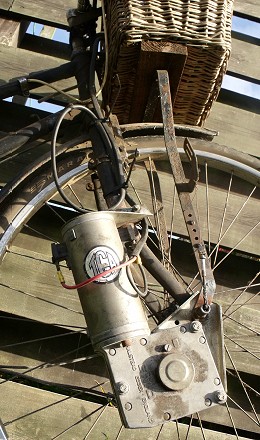
TGA Electrobike clip-on kit
Marketed by TGA Electric Leisure of Sudbury, Suffolk, the first TGA Electrobike clip-on kit was a pioneering effort in the early 1980s to produce and market commercially an attachable electro-booster set to cycles and tricycles by fitting a 200W × 12V motor with integral reduction gearbox made by Electric Motor Developments (EMD) of Halstead in Essex. The e-motor could be adapted to front or rear attachment, driving either single-speed or three-speed hubs by means of the chain and sprockets
For bicycles, the use of a heavy 12V lead acid car battery mounted on a frame above the rear wheel or on a forward carrier, proved awkward in both locations, giving a high centre of gravity, making handling difficulties for the comparatively light weight cycle frame, and serious complications if the unbalanced cycle happened to fall over, which it was inevitably going to do at some time. Due to the weight issues, TGA generally favoured the e-motor application more for tricycles, which they generally adapted and assembled themselves, for sale as complete machines.
Running a three-speed driving 26-inch wheel in first gear generated around 8mph on the flat, up to 12mph in second gear, and up to 15mph maximum in third, and though a healthy 12-volt supply battery could reportedly offer a 20-mile range on a full charge, it needed to be appreciated that rider assistance would also be required to build up speed and against inclines, when load on the motor would be at its greatest.
Because of its 200W rated motor, we think that the TGA Mk1 Electrobike kit was probably one of the earliest units built within the newly approved electric bike specifications as passed to legislation in August 1983, and therefore date these Mk1 units around 1984.

In the early 1980s, and limited by the electrical technology of the time, any smaller and lighter battery generally only meant less power and less effective range.
For an electric bicycle to work as a viable proposition, what the TGA e-bike needed was more power, less weight, a lower centre of gravity, and basing around a purpose-built machine rather than a common bicycle, which would probably never seem up to the job.
The Mk1 kit was subsequently replaced by a 24V Electrobike Mk2 version, retailed as a complete bicycle, where the motor mounted beneath the main down tube of a ‘shopper’ cycle, and drove a secondary freewheel sprocket at the pedal crank. The motor was controlled by a graduated throttle through a speed controller, and could be assisted at any time by normal pedalling.
Our TGA Mk2 Electrobike is nominally dated to about 1985, based off the 3–85 date coding marked on its Sturmey–Archer Elite AT3 Alloy three-speed rear brake hub. The manufacturer is now indicated as ‘The TGA Tricycle Co. Suffolk’, so a slight change of name in the business from the earlier kit, since David Stone at TGA had subsequently begun building numbers of tricycles. These tricycles often used a range of GRP fittings moulded by Jim Lawson at Lawson Engineering at Bishops Stortford, who was also employed on the Zorplan Shopper/Puch Maxi based tricycles built by Thomas Brothers, of Bishops Stortford and Harlow.
Based on a 20-inch wheel shopper-bike with a 16-inch frame, serial 783237, the Mk2 Electrobike weighed in at 5st 12lb (37kg), distributed as 1st 7lb front / 4st 5lb rear. The motor mounting is now welded beneath the main spine and, once again the motor is a 200W rated unit from EMD at Halstead, and powered by two 12V×18Ah batteries connected in series for 24V. A matching colour scheme runs through the bike, with a white painted frame, white painted electric motor casing, white handle grips, white pedals, white saddle, white rear carrier, and 37-451 / 20×1⅜ Barum whitewall tyres.

The motor is moveable within its frame mounting for accommodating drive chain adjustment, as its output shaft comes out at 90º to the motor axis through a reduction box, to a freewheel sprocket on the right-hand side, which drives the outer chain wheel on the Shimano (Japan) alloy double-chain wheel and Selecta alloy pedal crank set, with an in-built freewheel to the crank centre—which is a really top quality piece of equipment of the time. What this means is that you can pedal the bike in a normal cycling fashion, then click-in the electro power as and when you want to drive on the motor without the pedals rotating-which is so much better than the Pandora. You can also further assist the electric motor by pedalling, as the rider’s cycling and e-motor transmission all delivers through the three-speed rear hub.
David Stone’s TGA Mk2 Electrobike really does seem like a well thought out design, and thoroughly purpose-built electric bike of its time.
The charger connects to a socket within the rear carrier to power up the batteries, and by the time the charge light has stopped blinking the following day, we should be ready to go. Turn on the isolator key, and let’s go for a ride … pedalling only, speeds in gears pace at 11mph in first, 17mph in second, and 21mph in third. The e-motor gearbox runs with a noticeable whine when you power the drive in, then we try out the same speeds in gears under e-motor power without pedal assistance, and clock maximums along the flat of 8mph in first, 11mph in second, and 15mph in third. A downhill run in a crouch on e-motor power alone paces to a fastest of 18mph. Generally the TGA Mk2 should be considered as an electrically assisted cycle, mostly to make the process easier for the rider.
Arriving at the shops, we buy a sliced loaf, a pint of milk, bag of sugar, box of teabags, and a packet of biscuits, then open the rear carrier top to put it inside and … argh! There’s no room to put anything in here, it’s already full with batteries, a speed controller, isolator switch, charging socket, and a nest of wires with connectors. Surely it’d be better to put all this stuff somewhere else, so you could use the bag for shopping?
We try and clip everything on the front parcel carrier, but it won’t all fit, so we put the milk and biscuits in our jacket pockets, then clip the rest on the parcel carrier. The biscuits fall out of our pocket on the way home, so they’re all broken, and the loaf ends up squashed by the sprung parcel clip.
The Electrobike is equipped with the same ESGE L12 Pletscher (Swiss) cast-alloy sidestand-cum-centrestand that was fitted on the Pandora, which doesn’t prove to be any more reliable on the TGA either. You put the bike on the stand, it seems steady enough with the front wheel off the ground, walk away, and then there’s a crash behind you.
The lights both operate from a switch on the headlamp, and seem to work on a 12V circuit from one of the batteries.
The rear hub brake proved completely ineffective, and the front calliper brake matched the rear’s performance exactly. It did appear that a thorough brake service might be overdue.
TGA still exists as an electric mobility products company, but has long ceased involvement with cycle related products and supports no spares or information for them.
![]()
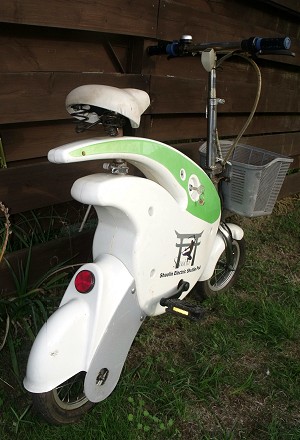
Last up, we present the ‘Shaolin Electric Shuttle Pod’, not for any other reason than its eccentric novelty. We can’t tell very much about its origins other than it seems to hail from somewhere in the far orient, and probably owes nothing to the Shaolin Chan Buddhist temple in Dengfeng County of Henan Province in China, which is believed to have been founded in the 6th century, and has become famously known as the origin of Shaolin Kung Fu martial arts.
Despite its title and graphic symbolism on both sides of the pod, we rather feel this particular electric bike shares very little in ancient connections with monks of the religious monastery or its traditional and finely honed combat techniques. There seems to be a Shaolin electric vehicle company in Henan Province making electric buses, but we can establish no positive connections to suggest that source might have been responsible for this electric cycle.
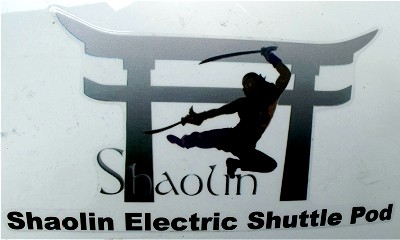
Presuming the electric motor and battery(s) lurk somewhere within the depths of its plastic pod, transmission to the rear wheel comes out from the pod by chain to a sprocket on the right-hand side, while a band brake is connected to the left, and operated from Wuxing brake lever sets up on the handlebars, with a calliper front brake. Sunmoon hubs are laced into tiny alloy rims by a total of just 20 spokes for each wheel, and fitted with 12½×2¼ unbranded tyres. The handlebar set has a folding latch at the top yoke, with a second clamp up the stem to enable easy adjustment of the handlebar height, then a further clamp to enable easy adjustment or removal of the saddle stem-so the Shaolin seems intended as compact folding electric cycle. While the total length of the machine is just a diminutive 45 inches long, the lowest 34-inch saddle height setting suggests it was not intended as any child’s toy. Close to the charging point socket, a lockable ignition in the upper right-hand pod works by a removable key and activates a small charge status indicator display unit attached to the handlebar, which lights up with fairly obvious red/green/green LEDs. A twistgrip throttle control turns to feed in the electric power, though probably the bike’s primary motion might be intended from the rider pedalling, because although it feels to snap away when you turn the throttle off the bike, put someone on the saddle and it’s a rather a different story. With a rider aboard, Shaolin seems to just crawl along at walking pace.
We recharge the battery overnight, and next morning the charge level indicator shows two full green lights, but it’s just the same to ride. We take it out along the road to pace with the sat-nav and, under its own e-motor power along the flat: 5mph. On a slight downhill stretch: 6mph, and going back up the same shallow section: just 4mph. Pathetic! You can pedal it faster even on its single speed ratio-up to 15mph actually, if you’re prepared to put some effort in.
The electric motor drive seems so slow that it’s almost pointless but, shortly after the test, Wills is riding the Shaolin up and down the pavement, when the pedal crank seems to disengage and derails the chain. Chris then decides its time to take the pod apart and investigate the problem, which proves to have been caused by a dislocated circlip on the pedal crank, but we’re surprised at how much busy mechanics live inside the pod!
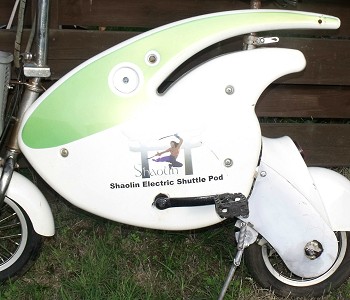
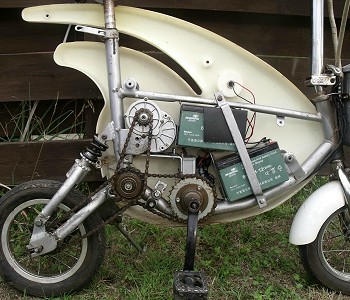
There are two 12V×12Ah sealed lead acid batteries connected in series for 24V, to a 24V×250W e-motor, driving through an attached reduction gearbox by chain to an intermediate triple sprocket set. The pedal shaft also drives the triple sprocket set by another chain, and then the triple sprocket set outputs to the rear wheel. There are three freewheels in the system, on the pedal crank, on the intermediate triple sprocket, and on the rear wheel, which allows free drive from pedal action, or the e-motor, or allows the bike to freewheel. In removing the rear mudguard assembly, we’re also surprised to discover that there’s a miniature mono-shock rear suspension arrangement, which would seem completely inexplicable for such a small and slow machine! Looking at the wiring between the e-motor and the speed controller, Chris notices a small heat-shrunk junction in one of the supply wires, with a screw head in one end… which looks like a potentiometer maybe? So, with Wills holding the bike up on the side-stand with its back wheel off the ground, and the throttle wide open with the e-motor driving, Chris turns the pot screw fully open-and the motor revs increase quite markedly! Following re-assembly, it’s obvious that the tune-up has made a significant improvement. So we repeat exactly the same course along the road to pace with the sat-nav and, under its own motor power along the flat: now 9mph. On the slight downhill stretch: 11mph, and going back up the same shallow section: it’s now up to 7mph. Wills subsequently rode the ‘Pod’ around town for quite a while over the following week, which proved to have a surprisingly good range on the e-motor drive, with very little pedalling employed. The neat little prop stand stood the bike securely when parked, where it invariably attracted much curiosity. The two internal batteries were fully marked in Chinese, so presumed to be the originals, and dated 2001, so we take this as some indication to reasonably date the vehicle. The Shaolin Electric Shuttle Pod looks novel and gimmicky, but how many people might actually ride one for transport in the west? Well, it seems that Wills might now be favouring the Shaolin over his usual bicycle.
New Electrically Assisted Pedal Cycle regulations to harmonise with EU law came into force on 6th April 2015, replacing the previous 1983 UK regulations. These latest specifications now state that: Electric assistance can only be provided to a maximum of 25 km/h (15.5 mph), the motor rated no more than 250W, the e-bike’s pedals must be in motion for motor assistance to be provided, and the rider must be 14 years of age or over, and an EAPC vehicle is road legal to use without licence or insurance.
Earlier throttle controlled e-bikes with a 250W motor rating which operated before the new regulations were introduced, still remain legal to ride, so can be legally purchased and used as second hand models.

